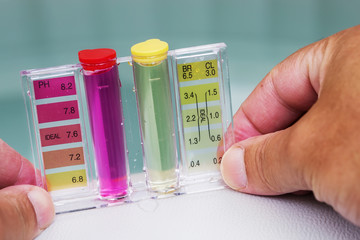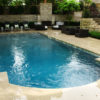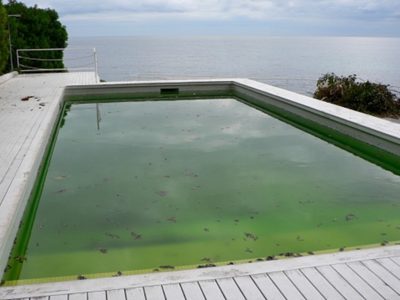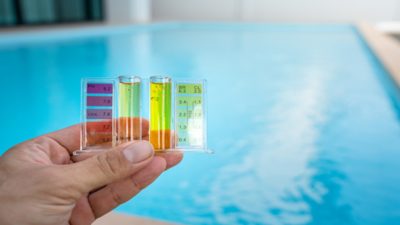The key success of every swimming pool owner is the achievement of clean, sanitized, and healthy pool water without any germs and infections. No one likes a dirty and infected pool. To keep your pool sanitized and germ-free, you need a disinfectant like bromine or chlorine.
Particularly, if we talk about bromine, it is an element from the same family as chlorine. It is a very important cleaning element, especially for indoor swimming pools. It is found naturally in the seawater at higher levels and is brownish-red in color. Bromine is a disinfectant, algaecide, oxidizer, and sanitizer that help to clarify the swimming pool water by killing microorganisms, viruses, and bacteria. Not only this, but bromine also has a tendency to combine with other elements to keep the water neutral and safe to swim. It is more useful in closed regions like indoor pools, spas, and hot tubs because bromine can withstand high temperatures. For outdoor swimming pools, bromine can become unstable due to exposure to sunlight.
For sanitizing and cleaning the swimming pool water, pool owners mostly use tablets and solutions of bromine compounds. Keep in mind that you don’t use bromine in the raw form. Whenever you use bromine in liquid form for the pool water, make it dilute otherwise it can cause harm to your skin and eyes. Bromine is an alternative to chlorine for disinfecting swimming pools. Although chlorine is cheaper as compared to bromine but bromine is more effective in high pH levels and warm temperatures. Bromine has several advantages as it provides the best outcome when incorporated into swimming pools. Below are discussed some of the effectiveness of bromine on swimming pool water.
1. Odor of Bromine
“Bromine” word is originated from the word “bromos”, which is a Greek word meaning “smell”. Here, the word “smell” means that the odor of bromine is stinging and unpleasant, and smells like bleach.
For sanitizing the pool, firstly, add bromine salt to the water. Secondly, add an oxidator (hypochlorite or ozone) to activate the bromine that results in the formation of hypobromous acid (HOBr). During disinfection, the dissociation of hypobromous acid occurs which produces the bromide ions. These bromide ions further react to produce disinfectants. These bromine-containing disinfectants give off little or no smell. Chlorine, on the other hand, produces more smell when used instead of bromine. Sometimes, if the concentration of bromine in swimming pool water becomes excessive, it also produces an annoying smell.
Another reason for having less smell of bromine as compared to chlorine in the pool water is their natural state. When you add bromine in liquid form (which is its natural state) into the water, it sanitizes the water and does not tend to “gas off”. This is because liquid bromine stays at rest and produces less smell. Whereas, the natural state of chlorine is gaseous which “gas off” and goes into the air. Because of its “gas off” nature, the swimmer can easily inhale it and hence feel a pungent smell. Therefore, it is ideal to use bromine in indoor swimming pools or spas.
2. Sanitizing Ability of Bromine
Bromine sanitizes the pool water by killing microorganisms, bacteria, and organic matter including algae spores, debris, dirt, etc. The sanitizing ability of bromine remains effective in the pool because it does not convert into a gaseous state. Chlorine, on the other hand, converts into the gaseous state and loses its sanitizing ability. When you use chlorine for sanitizing pool water, you have to add it more often with time. Contrary to this, if you use bromine, it will convert into bromine compounds. After this conversion, you just have to re-activate them only when their efficiency to sanitize becomes low. Bromamines (product form if ammonia is present in the pool) can also kill microorganisms and bacteria like free bromine or free chlorine. The formation of bromamine can lead to a decrease in expenses of bromine’s high cost and labor.
3. Oxidizing Power of Bromine
If we talk about the oxidizing power of bromine, it is low as compared to chlorine. It means that if you want to remove the masses of waste from the swimming pool water using bromine, you have to use chlorine shock or monopersulfate along with it. For people owning small indoor swimming pools or hot tubs, bromine tablets are a good choice as they can disperse in small areas more efficiently.
Bromine is not only effective in warm water temperatures but also in swimming pools having high pH levels. If we say that 4 to 5 people simultaneously enter into the swimming pool then it can cause an increase in the pH level of pool water. In this case, if the pH level becomes above 8 and we are using chlorine then its efficiency will be reduced by 50%. So, bromine is more effective to use in this situation as it can retain its effectiveness in high pH levels.
4. Effect of Bromine on Skin

As we have discussed previously that we do not need to add more and more bromine just like chlorine, thus there will be less amount of chemical (bromine) in the swimming pool. The lesser the chemical in the pool, the lesser will be the irritation to the skin. The addition of bromine in the swimming pool is a good option for people having skin and eye issues with chlorinated water but constant contact with the bromine can also lead to skin irritations. The direct splashing of bromine on the skin can also cause skin burns or damage.
Furthermore, in some cases, people who swim in bromine-treated swimming pool water can get reddened dry skin or patches, blistered skin, irritation in the respiratory system, mucous membranes irritation, or itching. The eye and skin irritations occur when the concentration of bromine reaches above 3 ppm but usually, the amount of bromine required to kill bacteria and microorganisms in the swimming pool water is very low that it does not affect most people.
Effect Of Bromine on Pets
Bromine is effective to not only humans but also other livings like our pets. Along with humans, our pets, like dogs, also like to swim during the hot summers. However, the presence of bromine in the swimming pool water can irritate the nostrils, eyes, and other parts of the skin of your pet or dog. It is a good choice to clean your dog with clear water after being played in bromine treated swimming pool. In this way, bromine can completely wash off your pet’s body and ensure their health safety. Still, bromine is better than chlorine for the sensitive mucous membranes of pets and humans.
5. Stability of Bromine at High Temperatures
Bromine can stay longer in hot water temperatures whereas chlorine becomes unstable in high water temperatures. The better option for warm water swimming pools, spas, and hot tubs is to use bromine. Its power to kill organic materials remains stable up to the temperature 58.8°C while on the other hand at 32°C, chlorine starts to “gas off”. Bromine does not gas off at higher temperatures and continues to disinfect the swimming pool water.
If we talk about the use of bromine then do not use it for the outdoor swimming pools. The reason behind this is the presence of sunlight whose ultraviolet rays degrade the bromine from the swimming pool. The bromine becomes unstable and more amounts need to be added frequently which can be costly for you. Although you can use bromine in those outdoor swimming pools that do not remain in contact with sunlight for more than two hours a day. It can also be used to the pools having solar covers or blue blankets that protect them from the ultraviolet rays of sunlight.
6. No Corrosion with Bromine

When you add bromine into the swimming pool water, it does not cause any corrosion with steel or other metals due to its stability. On contrary, chlorine when changes into a gas, produces chloramine which further leads to corrosion. Bromine, either in liquid form or in tablet or granular form, can dissolve easily into the water without causing any damage to the pipes, frames, equipment, and other steel or metal structured parts of the swimming pool. The recommended amount of bromine is between 3 to 5 ppm for commercial pools and 1 to 3 ppm for a residential pool. An ideal pH value for water is 7 but in reality, it may differ. The disturbance in pH is the main factor in causing corrosion. A very high temperature of swimming pool water may also lead to corrosion.
7. Inappropriate Use of Bromine
The addition of an inappropriate amount of bromine in the swimming pool can form compounds or by-products named “Bromamines”. The formation of these compounds occurs due to the presence of ammonia in the pool that comes from different sources like airborne pollutants. The compounds of bromamines produced include tri-bromamine (NHBr3), di-bromamine (NHBr2), and mono-bromamine(NHBr). The formation of these compounds depends on the changes in the pH values. These compounds do not produce an unpleasant smell neither they cause skin and eye irritation as chloramines do. Due to the formation of bromamines, the amount of bromine becomes less in the pool. So the leftover amount of bromine in the pool will not be enough to remove all the microorganisms and bacteria.
Bromine Pool Shocking
As the formation of bromamines reduced the efficiency of bromine, there is a need to re-activate the bromine. For achieving the full efficiency of bromine, you have to shock the bromine pool. To break the contaminants and kill the bacteria, swimming pools are shocked from time to time. The bromine-treated pool is also shocked in a similar way as all other pools. You can shock the pool by adding hypochlorous acid, which leads to the formation of bromine through the re-activation of bromide ions. As soon as a bromide starts to produce in bulk amount in the swimming pool, you can do re-activation constantly. You can then maintain the free bromines or bromine residual by the addition of smaller amounts of bromine tablets.
The suitable amount of free bromine is almost between 2 ppm to 4 ppm. Though bromine is costly as compared to chlorine, we do not have to add more and more bromine because you can re-activate it, unlike chlorine. No doubt, bromamines are easy to cope with as compared to chloramines.
Summary
This article provides you with knowledge regarding the advantages of adding bromine to your swimming pools. It elaborated on how to keep your pool clean and healthy. For cleaning your pool with the best disinfectants, you need to know about the pros and cons of the chemical you are going to use. If we talk about bromine, you can add it into the swimming pool water in different forms like tablets, granular, or liquid. You can add them through an electrolytic generator or automatic bromine feeders. It has less chemical odor with stable disinfecting capability as compared to chlorine. Bromine performs its tasks of killing bacteria and viruses thereby sanitizing the pool water with efficacy. Not only in normal water temperatures of the pool but also at high-water temperatures, bromine can withstand and continue its tasks.
Moreover, it is easy and gentle to the skin of the swimmers and pets if not exposed constantly. Not only to living beings, but bromine also does not cause any harm to the steel or other metal parts of the swimming pool that means no corrosion can occur. Last but not the least, the bromine-treated swimming pools can be re-activated, unlike chlorine-treated pools.
It is now clear to the readers that what are the effects of adding bromine in swimming pool water and the factors influencing its quality. You can now easily select a chemical disinfectant for your pool, either chlorine or bromine, according to your budget and need.






